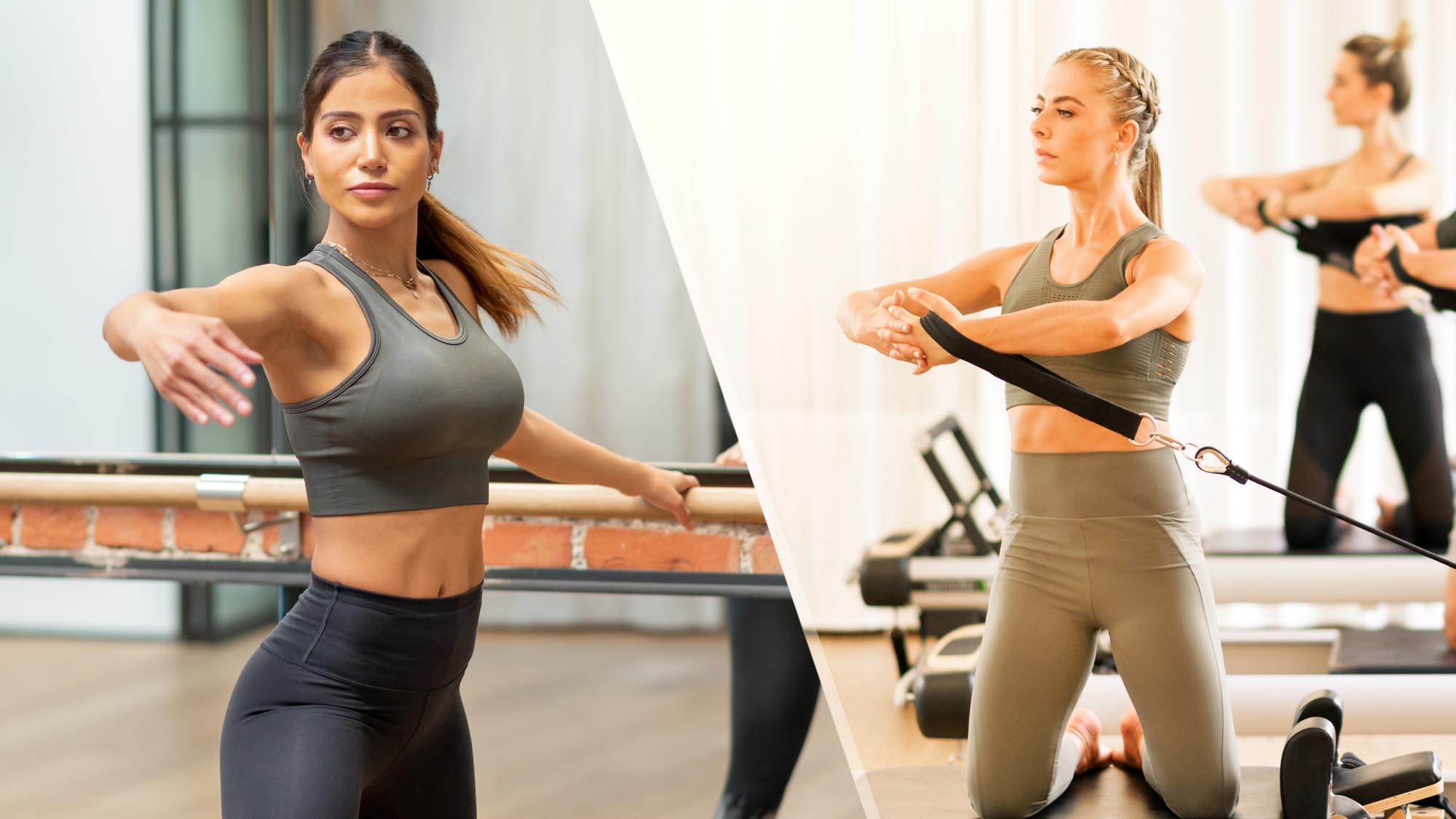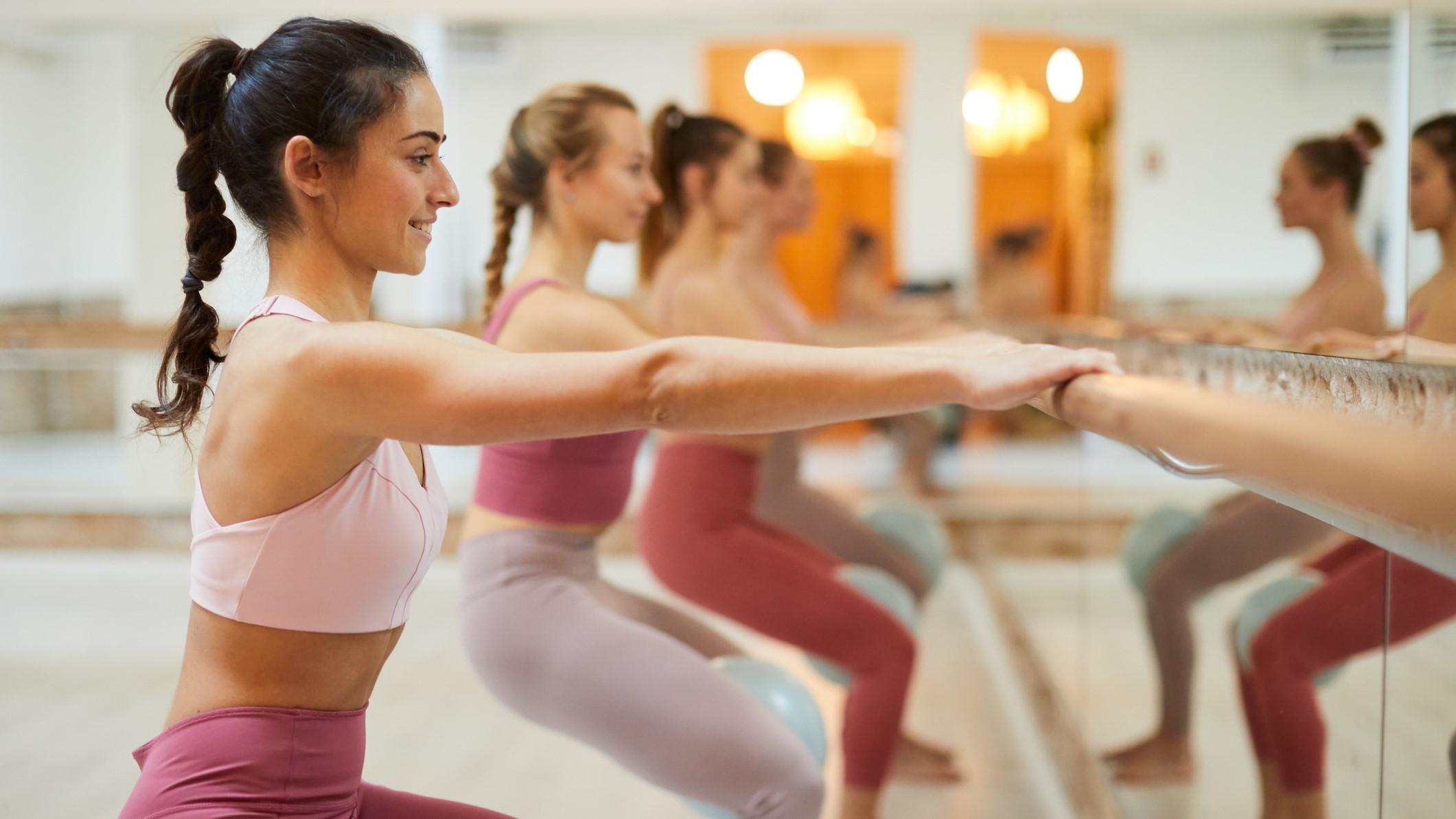Barre vs. Pilates: Which burns more calories?

With so many different exercise classes to choose from, but only so many free hours in your week to fit them into your schedule, it can be tricky to know what to choose, especially when, on paper, they look similar.
Take barre and Pilates for example — both are low-impact, both work on strength and flexibility, and both have connections to dance. But which is right for you and your body, which gives you a better workout, and which burns more calories? Read on to find out more.
Let’s start by taking a quick look at the history of both exercises. Barre was created by the late ballerina Lotte Berk in 1959. Berk combined the elements of dance training with yoga, and physiotherapy following a back injury, to create a low-impact, but effective form of training.
The principles of barre remain the same — workouts consist of high reps of low-impact exercises, using either light weights or body weight. Sometimes movements will be next to a ballet barre, other times they are in the center of the room. Each exercise is meant to be performed to fatigue, immediately followed by stretching to lengthen muscles.
Pilates was developed by German bodybuilder Joseph Pilates while working as an orderly during World War I. He is said to have used exercises we now recognize as Pilates to rehab patients while being held in an internment camp, utilizing equipment available to him, like bed springs and beer keg rings.
While he wasn’t a dancer, it’s said the workout appealed to the dance community as a way to rehab from injuries. Joseph Pilates was said to have been influenced by Zen Buddhism, and the idea of mind-body connection, which runs through Pilates today.

Barre vs. Pilates: The similarities
Both barre and Pilates are low-impact forms of exercise, with a focus on strengthening the muscles and improving flexibility. Here are the similarities between the two forms of exercise:
Get instant access to breaking news, the hottest reviews, great deals and helpful tips.
Both classes have similar exercises
There’s a lot of crossover between Pilates and barre, and some exercises will crop up in both, especially if you’re taking a mat Pilates class. Both mat Pilates and barre won’t use a lot of equipment — usually, classes will focus on your body weight, or add light weights, resistance bands, or an exercise ball.
Both classes will feature a lot of isometric exercises and isometric holds. Isometric exercises are when the muscle fibers are fixed in length throughout, like a pulse squat in barre or a plank in Pilates.
Both increase flexibility
Both Pilates and barre aim to increase flexibility in the body. Barre does this by focusing on elongation in the entire body — you’ll often find your teacher reminding you to stand up straight like a ballerina during class. Pilates also improves flexibility and posture by focusing on full-body alignment. In other words, whether you pick Pilates or barre, the aim is to work on longer, stronger muscles.

Barre vs. Pilates: The differences
There are, however, some key differences between the two exercise classes. Here’s what to consider before you sign up:
The equipment used
Here’s where things get a little more complicated — if you opt for a reformer Pilates class or a Megaformer class, the equipment will be different. Reformer Pilates is practiced on the reformer machine — a large frame-like structure with a sliding bed called a “carriage” that you can lay or stand on. Various coiled springs attach to the carriage to add intensity through resistance to Pilates exercises, alongside various pulleys and handles that diversify the workout further by working your entire body.
Pilates classes can also be divided into beginner, intermediate, and advanced classes, the latter being the most challenging. Advanced classes tend to burn more calories and work the muscles harder, and there’s also Inferno Pilates (high-intensity hot Pilates) which could potentially burn more.
The focus
The focus of the two classes is also slightly different. While barre works muscles to exhaustion, Pilates doesn’t. Barre also tends to focus more on the lower body and isolating muscle groups, whereas Pilates has a strong focus on the core — all Pilates exercises start with the core, and the fundamentals of Pilates are around stabilizing the back, hips, and core.
Barre vs. Pilates: Which burns more calories?
On average, and according to this calorie counter (modeled on the Compendium of Physical Activities) a 160-lb person engaging in one hour of Pilates can expect to burn around 200–250 calories. This increases slightly on the reformer to 220-300. The calories you burn through exercise vary from person to person, and factors like age, weight, and duration come into play. For a more accurate idea of how many calories you’ve burned, it’s a good idea to invest in one of the best fitness trackers.
On average, a 160-lb person will burn around 230-250 calories in a barre class, but again, this can vary based on the intensity of the class. As you can see, there’s not an awful lot of difference between the two forms of exercise from a calorie-burning perspective.

Barre vs. Pilates: Which should you choose?
When it comes to which you should choose, the answer lies in which style of low-impact exercise you enjoy more. Both strengthen and sculpt your muscles, can help relieve stress, get your heart rate up, and benefit your mental health.
That said, if you’re looking to build a rock-solid core, Pilates is the better choice, whereas if you prefer a dance-style workout, you might enjoy the repetitive beat of a barre class. If you enjoy exercise, you’re more likely to want to do it, and more importantly, be more inclined to stick with it, so why not try a barre class and Pilates class to work out which is right for you?
More from Tom's Guide
- Forget planks — this standing ab workout blasts your core in just 10 minutes
- Here’s what an hour of Pilates can do for your body
- I tried this 20-minute barre workout — and was surprised by the results

Jane McGuire is Tom's Guide's Fitness editor, which means she looks after everything fitness related - from running gear to yoga mats. An avid runner, Jane has tested and reviewed fitness products for the past five years, so knows what to look for when finding a good running watch or a pair of shorts with pockets big enough for your smartphone. When she's not pounding the pavements, you'll find Jane striding round the Surrey Hills, taking far too many photos of her puppy.
